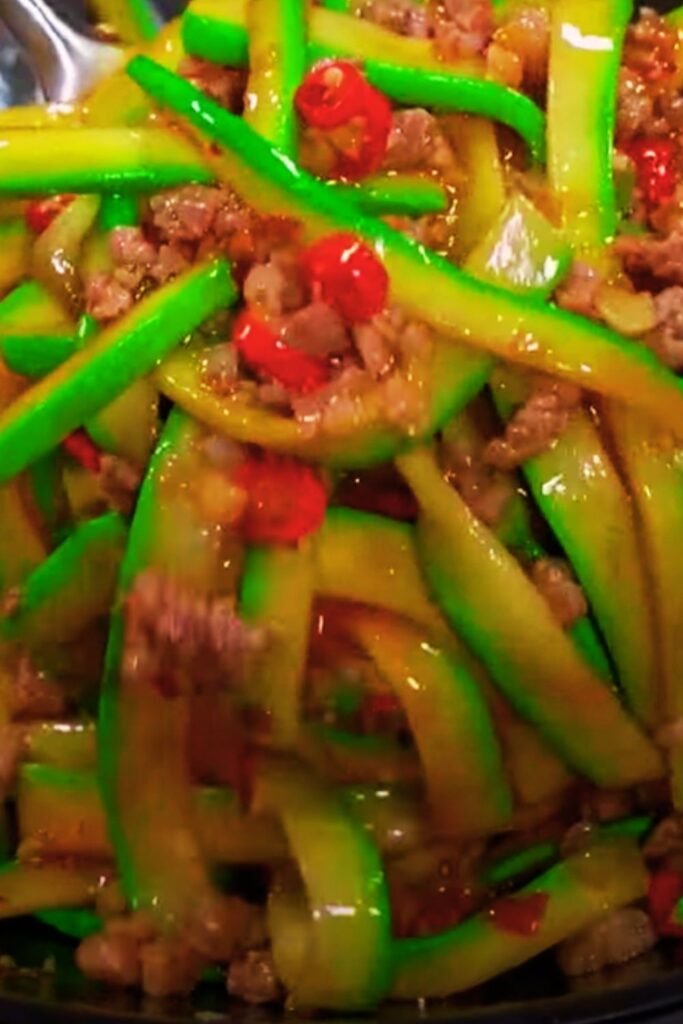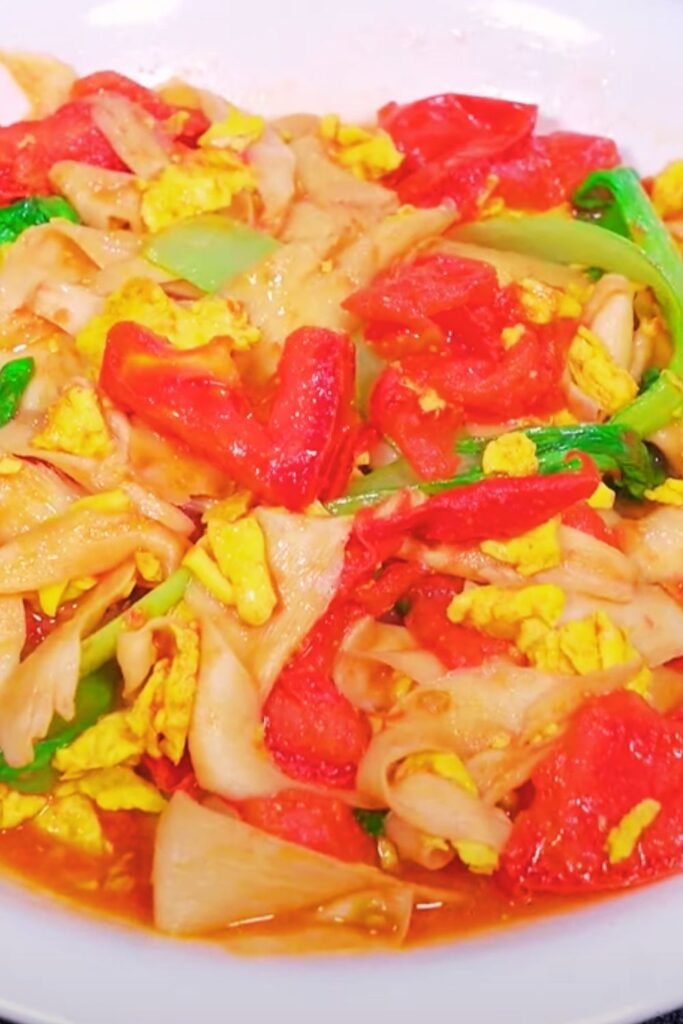I’ve always been fascinated by the bold, mouth-tingling flavors of Szechuan cuisine, but finding keto-friendly versions can be challenging. That’s exactly why I created this Simple Szechuan Keto Zucchini Stir Fry – it delivers all those authentic spicy, numbing sensations while keeping you firmly in ketosis and perfectly aligned with the Trim Healthy Mama Deep S guidelines.
This isn’t just another vegetable stir fry thrown together with random seasonings. I’ve spent months perfecting this recipe, testing different combinations of Szechuan peppercorns, chili oils, and low-carb vegetables to create something that truly captures the essence of traditional Szechuan cooking without derailing your health goals. The result is a dish that’s become my go-to weeknight dinner when I’m craving something bold and satisfying.
What makes this recipe particularly special is how it transforms humble zucchini into something extraordinary. The key lies in understanding how Szechuan flavors work together – the má (numbing) sensation from Szechuan peppercorns, the là (spicy heat) from dried chilies, and the complex umami depth from fermented black beans and garlic. When these elements combine with properly prepared zucchini, magic happens.
Understanding Szechuan Flavors in Keto Context
Má (Numbing Sensation): The distinctive tingling, numbing sensation that comes from Szechuan peppercorns. These aren’t actually peppercorns but dried seed pods from the prickly ash tree.
Là (Spicy Heat): The burning heat from dried red chilies, particularly the small, intensely hot varieties preferred in Szechuan cooking.
Xiān (Fresh/Umami): The savory depth achieved through ingredients like fermented black beans, soy sauce, and fresh aromatics.
Suān (Sour): A subtle tartness that balances the heat, often from rice vinegar or, in our keto version, apple cider vinegar.
Tián (Sweet): Traditionally from sugar, but we’ll use erythritol to maintain ketosis while providing that essential flavor balance.
The beauty of adapting Szechuan cuisine for keto lies in how naturally these flavors complement high-fat, low-carb ingredients. The richness of oils and proteins actually enhances the perception of these complex flavors rather than masking them.
Why Zucchini Works Perfectly
I chose zucchini as the star vegetable for several compelling reasons. First, its mild flavor provides the perfect canvas for bold Szechuan seasonings without competing for attention. Second, zucchini’s high water content means it releases moisture during cooking, creating a natural sauce base when combined with our aromatics and seasonings.
From a nutritional standpoint, zucchini is incredibly keto-friendly. One medium zucchini contains only about 4 net carbs, making it perfect for a Deep S meal. It’s also rich in potassium, vitamin C, and folate, while being naturally low in calories – though we’ll be adding plenty of healthy fats to make this a proper Deep S dish.
The texture aspect is crucial too. When cut properly and cooked at the right temperature, zucchini maintains just enough bite to provide textural interest while absorbing all those incredible Szechuan flavors. I’ve found that cutting zucchini into half-moons about ¼-inch thick gives the best results.
Essential Ingredients Breakdown
| Ingredient | Quantity | Carbs per Serving | Role in Dish | Substitution Options |
|---|---|---|---|---|
| Medium Zucchini | 3-4 (about 2 lbs) | 3g net carbs | Main vegetable base | Yellow squash, chayote |
| Szechuan Peppercorns | 2 tablespoons | 0g | Má (numbing) flavor | Pink peppercorns (milder) |
| Dried Red Chilies | 8-10 pieces | 0.5g | Là (heat) element | Red pepper flakes |
| Avocado Oil | 3 tablespoons | 0g | Cooking fat, Deep S compliance | Coconut oil, ghee |
| Fresh Ginger | 2-inch piece | 1g | Aromatic base | Ground ginger (1 tsp) |
| Garlic Cloves | 6 large | 1g | Aromatic foundation | Garlic powder (2 tsp) |
| Fermented Black Beans | 2 tablespoons | 1g | Umami depth | Coconut aminos + salt |
| Tamari Sauce | 3 tablespoons | 1g | Salty umami base | Coconut aminos |
| Apple Cider Vinegar | 1 tablespoon | 0g | Suān (sour) balance | Rice vinegar |
| Erythritol | 1 teaspoon | 0g | Tián (sweet) balance | Stevia (1/4 tsp) |
| Sesame Oil | 1 tablespoon | 0g | Finishing flavor | None – essential |
| Green Onions | 4 stalks | 1g | Fresh finish | Chives |

Step-by-Step Preparation Method
Preparation Phase (10 minutes)
My approach to stir-frying emphasizes preparation over speed during cooking. Once the wok gets hot, everything happens quickly, so having all ingredients prepped and within arm’s reach is crucial.
- Toast the Szechuan peppercorns in a dry pan over medium heat for 2-3 minutes until fragrant. You’ll know they’re ready when they start releasing that distinctive numbing aroma. Let them cool completely, then grind them coarsely in a spice grinder or mortar and pestle.
- Prepare the zucchini by washing and trimming the ends. Cut into half-moon slices about ¼-inch thick. I’ve found this thickness provides the perfect balance between cooking through properly and maintaining some texture.
- Create your aromatics by mincing the ginger and garlic as finely as possible. The smaller the pieces, the more flavor they’ll release into the oil.
- Rinse the fermented black beans under cold water to remove excess salt, then chop them roughly. These little flavor bombs will distribute better throughout the dish when broken up slightly.
- Mix your sauce by combining tamari, apple cider vinegar, and erythritol in a small bowl. Stir until the erythritol dissolves completely.
Cooking Process (8-10 minutes)
The actual cooking happens in stages, building layers of flavor at each step. This technique, called “bào chǎo” in Chinese cooking, ensures every element contributes maximum flavor to the final dish.
Stage 1: Oil Infusion (2 minutes) Heat your wok or large skillet over medium-high heat until it just begins to smoke. Add the avocado oil and immediately add the dried chilies. Let them sizzle for about 30 seconds – they should darken slightly but not burn. The oil will take on a beautiful red color and spicy aroma.
Stage 2: Aromatic Foundation (1 minute) Add the minced ginger and garlic to the infused oil. Stir constantly for about 45 seconds until incredibly fragrant. This is where the magic begins – the combination of the chili oil with fresh aromatics creates the flavor base that makes Szechuan cuisine so distinctive.
Stage 3: Umami Development (1 minute) Add the fermented black beans and ground Szechuan peppercorns. Stir for another 30-45 seconds. You’ll notice the numbing sensation becoming more pronounced as the peppercorns heat up.
Stage 4: Vegetable Cooking (4-5 minutes) Add the zucchini slices in a single layer if possible. Let them sear without moving for about 2 minutes – this develops some caramelization and prevents them from becoming mushy. Then stir-fry for another 2-3 minutes until tender-crisp.
Stage 5: Final Assembly (1 minute) Pour the sauce mixture over the zucchini and toss to combine. The sauce should coat everything evenly and reduce slightly. Remove from heat and drizzle with sesame oil, then garnish with sliced green onions.

Nutritional Profile and THM Deep S Compliance
This recipe perfectly exemplifies what makes a dish Deep S compliant while delivering incredible satisfaction and flavor. Let me break down exactly why this works so well within the Trim Healthy Mama framework.
Complete Nutritional Analysis
| Nutrient | Per Serving (4 servings total) | % Daily Value | THM Notes |
|---|---|---|---|
| Calories | 145 | 7% | Perfect for Deep S |
| Total Fat | 12g | 18% | Excellent healthy fat ratio |
| Saturated Fat | 2g | 10% | Within healthy range |
| Net Carbohydrates | 4g | 1% | Excellent for ketosis |
| Fiber | 3g | 12% | Supports digestive health |
| Protein | 4g | 8% | Can pair with protein |
| Sodium | 580mg | 25% | From tamari and black beans |
| Potassium | 420mg | 12% | Excellent electrolyte support |
| Vitamin C | 35mg | 39% | Immune system support |
| Folate | 40mcg | 10% | Essential B vitamin |
Deep S Compliance Features
High Healthy Fat Content: The avocado oil and sesame oil provide the majority of calories from healthy fats, keeping you satisfied and supporting hormone production.
Ultra-Low Carbs: With only 4 net carbs per serving, this dish leaves plenty of room for other Deep S foods throughout the day.
No Inflammatory Ingredients: Every ingredient is chosen to support rather than hinder your health goals.
Naturally Satisfying: The combination of fats and fiber creates lasting satiety without blood sugar spikes.
Customization and Variations
One of the things I love most about this recipe is how adaptable it is to different preferences and dietary needs. Here are my favorite variations that I’ve developed over time.
Protein Additions
While this dish is perfect as a vegetarian side, adding protein transforms it into a complete meal:
- Chicken Thighs: Cut into bite-sized pieces and cook before adding vegetables
- Pork Belly: Dice and render the fat first, using it as part of your cooking oil
- Tofu: Use extra-firm, pressed and cubed, perfect for vegetarian Deep S
- Eggs: Scrambled in at the end for a different texture and added protein
Vegetable Variations
The technique works beautifully with other low-carb vegetables:
- Cauliflower: Cut into small florets, needs slightly longer cooking time
- Broccoli: Steam briefly first, then add to stir-fry for final 2 minutes
- Bok Choy: Separate stems and leaves, cooking stems first
- Green Beans: Trim and cut into 1-inch pieces, cook similarly to zucchini
Heat Level Adjustments
Not everyone loves the same level of spice, so here’s how to customize:
For Mild Heat: Use only 3-4 dried chilies and 1 tablespoon Szechuan peppercorns For Extra Heat: Add fresh sliced jalapeños with the aromatics For Nuclear Heat: Include some ground ghost pepper or Carolina Reaper (use sparingly!)

Serving Suggestions and Meal Planning
This versatile dish works beautifully in various meal contexts. As a Deep S meal, you want to pair it with other high-fat, low-carb options to maintain the proper macronutient balance.
Complete Deep S Meal Ideas
Asian-Inspired Deep S Plate: Serve alongside sesame-crusted salmon or teriyaki chicken thighs with a side of shirataki noodles tossed in garlic oil.
Comfort Food Version: Pair with keto fried “rice” made from cauliflower rice, eggs, and plenty of butter or coconut oil.
Light Summer Meal: Serve over a bed of butter lettuce with sliced avocado and a sprinkle of hemp hearts for extra healthy fats.
Hearty Winter Option: Combine with slow-cooked pork shoulder or beef short ribs for a warming, satisfying meal.
Make-Ahead and Storage Tips
This dish actually improves in flavor after sitting for a few hours, making it perfect for meal prep. Store in the refrigerator for up to 4 days, and the flavors will continue developing.
For reheating, I prefer using a skillet over medium heat rather than the microwave, which can make the zucchini soggy. Add a splash of water or broth if needed to prevent sticking.
Troubleshooting Common Issues
Over the months I’ve been making and sharing this recipe, I’ve heard from many people about their experiences. Here are the most common issues and how to solve them:
Problem: Zucchini becomes mushy Solution: Don’t overcrowd the pan, and let zucchini sear without moving initially
Problem: Not spicy enough Solution: Toast more dried chilies in the oil, or add a pinch of cayenne
Problem: Too salty Solution: Rinse fermented black beans longer, or reduce tamari amount
Problem: Lacks depth of flavor Solution: Make sure Szechuan peppercorns are freshly ground, and don’t skip the toasting step
Problem: Oil spattering everywhere Solution: Pat zucchini completely dry before adding to hot oil
The Science Behind Szechuan Flavors
Understanding why Szechuan cuisine works the way it does has helped me create better versions of traditional dishes. The numbing sensation from Szechuan peppercorns comes from a compound called hydroxy-alpha-sanshool, which activates touch receptors in your mouth rather than taste buds.
This creates space for other flavors to shine through in ways they couldn’t in a “normal” spicy dish. The heat from chilies activates pain receptors, while the numbing effect provides relief, creating a cycle that keeps you coming back for more.
From a keto perspective, this complex flavor profile means you don’t need to rely on carbs for satisfaction. The interplay of sensations keeps your palate engaged and satisfied in ways that simple salt or fat alone cannot achieve.
Beyond the Recipe: Cultural Appreciation
While I’ve adapted this dish for modern dietary needs, I want to acknowledge the rich culinary tradition it comes from. Szechuan cuisine, originating from China’s Sichuan province, has been refined over thousands of years. The use of Szechuan peppercorns dates back to ancient times, and the complex layering of flavors represents generations of culinary expertise.
By creating keto-friendly versions of these traditional dishes, we’re not just following a diet – we’re participating in an ongoing culinary conversation that spans cultures and generations. Each time you make this dish, you’re connecting with that tradition while adapting it for your modern health goals.
Questions and Answers
Q: Can I make this dish without fermented black beans? I understand that fermented black beans aren’t always easy to find, but they really do add a unique depth to the dish. If you can’t locate them, try mixing 1 tablespoon of coconut aminos with a pinch of salt and letting it sit for 10 minutes. It won’t be exactly the same, but it’ll provide some of that umami complexity.
Q: How spicy is this dish, and can children eat it? The heat level is moderate – I’d say it’s about a 6 out of 10 on the spice scale. The Szechuan peppercorns provide more numbing than burning heat. For children, I’d suggest reducing the dried chilies to just 2-3 pieces and using only 1 tablespoon of Szechuan peppercorns. You can always add more heat to individual portions.
Q: Will this recipe work in a regular skillet instead of a wok? Absolutely! While a wok provides better heat distribution and allows for more dramatic tossing, a large skillet works perfectly well. Just make sure it’s big enough that the zucchini isn’t overcrowded. I use my 12-inch cast iron skillet when my wok isn’t available.
Q: Can I freeze this dish for later? I don’t recommend freezing this particular dish because zucchini becomes very watery and mushy when frozen and thawed. However, you can prep all the aromatics and sauce ahead of time, storing them separately in the refrigerator for up to a week. Then it only takes 10 minutes to make fresh when you’re ready.
Q: Is this recipe suitable for other dietary restrictions beyond keto? Yes! This recipe is naturally gluten-free (make sure your tamari is certified gluten-free), dairy-free, and can easily be made vegan. It’s also Whole30 compliant if you substitute coconut aminos for the tamari and omit the erythritol. For AIP (Autoimmune Protocol), you’d need to omit the Szechuan peppercorns and dried chilies.
Q: What’s the best way to grind Szechuan peppercorns? I prefer using a dedicated spice grinder (a small coffee grinder works perfectly) because it gives you control over the texture. You want them coarsely ground, not powdered. If you don’t have a spice grinder, a mortar and pestle works well, though it takes more effort. Some people use a rolling pin, placing the toasted peppercorns in a sealed bag and crushing them.
Q: Can I double or triple this recipe for meal prep? You can definitely scale this recipe up, but I don’t recommend more than doubling it at once. The key is maintaining high heat throughout the cooking process, and too much food in the pan will cause the temperature to drop, leading to steaming rather than stir-frying. If you need larger quantities, it’s better to make multiple batches.
Q: How do I know if my Szechuan peppercorns are fresh enough? Fresh Szechuan peppercorns should have a strong, almost floral aroma with that distinctive numbing quality when you bite into one. If they smell musty or have no aroma at all, they’re too old and won’t provide the proper flavor. Store them in an airtight container away from light, and they should maintain quality for about a year.
This Simple Szechuan Keto Zucchini Stir Fry has become more than just a recipe in my kitchen – it’s become a bridge between traditional flavors and modern health goals. Every time I make it, I’m reminded that eating healthily doesn’t mean sacrificing the bold, exciting flavors that make food enjoyable. Whether you’re following THM, strict keto, or just looking for a delicious way to eat more vegetables, this dish delivers satisfaction on every level.